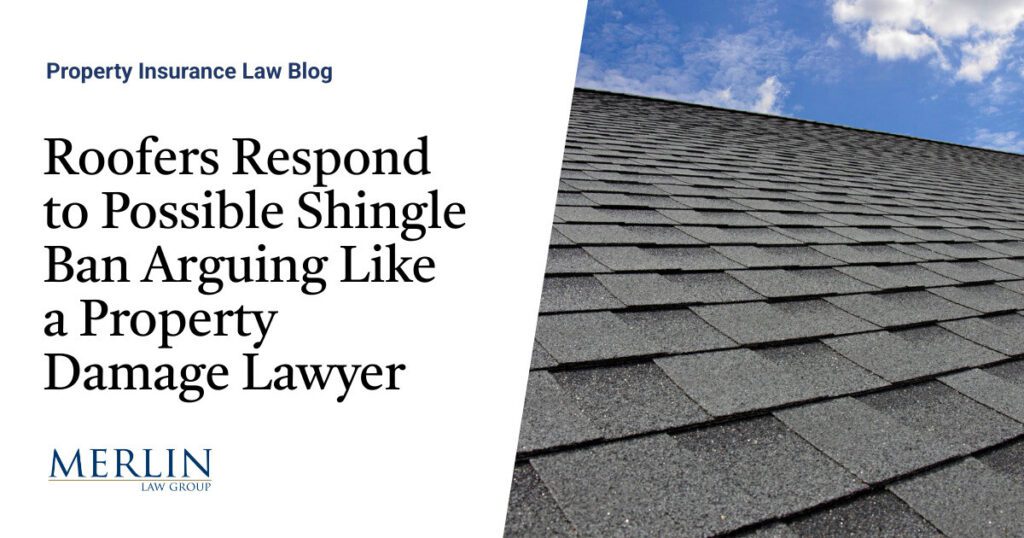Roofers Respond to Possible Shingle Ban Arguing Like a Property Damage Lawyer

Florida’s Insurance Commissioner, Mike Yaworsky, is not only going to hear from property damage attorneys about oversight of insurance companies, but he also certainly has the attention of Florida’s roofing industry after suggesting a ban on asphalt shingles. An article written by Ron Hurtibise and republished in the Tampa Bay Times, “Asphalt Shingle Roofs Lose Wind Resistance After 10 Years,” 1 stated:
Insurance Commissioner Michael Yaworsky expanded on the topic of asphalt shingle roofs that he first raised late last year when he said that they don’t last for 30 years in the state as some manufacturers claim.
‘Maybe it’s time to start writing them out of the plot in Florida,’ Yaworsky told the Florida Chamber’s annual Insurance Summit in December.
On Tuesday, Yaworsky revealed that a report completed in June by Applied Research Associates Inc. — citing tests by the Insurance Institute for Business & Home Safety and other organizations — found that the average life of a roof ‘where it has that real hurricane cat(astrophe) resistance is 10 years.’
I was the token property damage attorney on a Florida House panel a few weeks ago, testifying about insurance affordability. Commissioner Yaworsky commented that Florida roofs may have to be made of metal in the future if insurers are to continue to write insurance in Florida. While reducing the severity of property damage is important, the concept of doing away with asphalt shingle roofs is novel and would be met with a response from the roofing industry.
Mike Silvers of the Florida Roofing and Sheet Metal Contractors Association (FRSA) wrote an article, ‘It’s Time to Write Asphalt Shingles Out of the Plot in Florida’ Comment Causes a Firestorm. 2 I’ve been on the opposing side of the insurance industry lobby many times as an experienced property damage lawyer trying to advocate for policyholders. Silvers is clearly in the same seat representing the roofing contractor side of the issue when he wrote about Yaworsky:
If these comments were meant to bring attention to the subject, they certainly did. For many of us this is not a new topic. FRSA has been working with roofing product manufacturers and their representative groups to improve roof covering performance for decades. We are committed to learning from our post-hurricane observations and sharing that information with our members and the public. We build consensus through meetings and discussions with all segments of our industry. We, with our leadership’s approval, then go about implementing changes through participation in the Florida Building Code (FBC) modification process. We also interact closely with legislators and regulators on issues that could have an impact on our trade. The remarks made by such an important player in the property insurance arena have our attention….
I recently addressed the Asphalt Roofing Manufacturers Association (ARMA) at their Board of Directors meeting in Indianapolis and made a presentation titled Post-Hurricane Perceptions Matter. My goal was to bring them a Florida perspective and to reinforce ARMA’s interest in improving asphalt shingle roof performance after high wind events and how the perception and the narrative in Florida was not favorable to asphalt shingles. They were very receptive to the message and have been forthcoming in sharing the improvements in materials being made by many manufacturers. We will continue to work together through building code changes to improve materials, testing and application methods. ARMA is currently working with FEMA and conferring with FRSA to improve hip and ridge performance. This roof condition is where post-hurricane observations have found many failures in all roof covering types but especially with asphalt shingles. Addressing this issue could go a long way to reducing these failures. It is important to note that most often these hip and ridge failures do not lead to water intrusion. They are a part of a redundant roof system with multiple layers of material in these areas. They do, however, get recorded as damaged and thereby a ‘failure.’
Silvers is a seasoned roofing professional with over 50 years of experience. He acknowledges the limitations of asphalt shingles in Florida’s harsh climate. Maybe he should have thought about being a property damage lawyer because he persuasively argues that outright removal of asphalt roofing shingles from the market would be misguided. Instead of eliminating shingles, the FRSA emphasizes ongoing improvements in roofing materials, installation techniques, and building code enhancements to ensure better resilience. The organization shows its commitment to making Florida’s buildings more resilient by working closely with asphalt roof manufacturers, Florida’s legislators, and regulators to implement necessary modifications through the Florida Building Code (FBC) process.
Silvers highlights several critical factors in selecting the best roofing material for a structure. Building design and location play a significant role, as wind speed standards, surrounding topography, and proximity to saltwater influence roofing choices. The intended use of a building, whether as a primary residence, investment property, or condominium, affects long-term roofing decisions. Cost considerations and insurance implications also weigh heavily, particularly as insurers push for premature roof replacements, complicating financial decisions for homeowners and businesses.
While asphalt shingles have been criticized for their durability in hurricane-prone regions, Silvers argues that much of the damage results from improper installation rather than inherent material failure. Proper nail placement is crucial for wind resistance, yet errors in pneumatic nail gun usage can weaken shingle integrity. Post-hurricane assessments often fail to distinguish between functional failures, such as leaks and structural compromise, and cosmetic damage. Furthermore, building code limitations allow shingles to be installed by contractors who are not licensed roofing professionals, increasing the risk of improper application.
As an experienced and skeptical property damage attorney, I find the Residential Wind-Loss Mitigation Study 3 conducted for the Florida Office of Insurance Regulation to be a comprehensive analysis of windstorm loss mitigation. However, several aspects of its methodology and conclusions warrant scrutiny. The study places a significant emphasis on the vulnerability of asphalt shingle roofs, suggesting that their hurricane resistance diminishes after ten years. While there is merit in examining how Florida’s climate impacts roofing longevity, the report lacks transparency regarding the sample size and specific conditions under which this deterioration was measured. Without more detailed data on maintenance practices, installation techniques, and material variations, the assertion that asphalt shingles universally lose their effectiveness within a decade appears overly broad.
The study’s strong focus on alternative roofing materials, particularly metal roofs, raises questions about potential biases. While metal and tile roofs do offer greater durability, the report does not adequately consider the economic burden of transitioning homeowners away from asphalt shingles. Any property damage lawyer worth his salt would highlight that the initial cost of these materials can be significantly higher, and many policyholders may struggle to afford such upgrades. The study does not explore policy solutions such as phased implementation, financial assistance programs, or incentives that could make resilience more accessible.
Another area of concern is the reliance on climate projections using the RCP 6.0 scenario, which assumes a moderate emissions pathway for future hurricane activity. While it is prudent to factor in climate change, the study does not account for historical fluctuations in storm intensity and frequency. The reliance on a single climate model by the company assigned to do the research introduces uncertainty and may overstate the urgency of transitioning away from asphalt shingles. Additionally, the use of insurance loss data from 2018 to 2023 lacks a clear breakdown of claim circumstances, policy conditions, and how depreciation factored into settlements. Without this context, it is difficult to determine whether the study’s findings reflect genuine structural vulnerabilities or evolving insurance practices that reduce payouts for aging roofs. I am suggesting, as a litigation property insurance lawyer, that the methodology, while advanced, leaves important questions unanswered, particularly regarding affordability and the practicality of its recommendations.
Yaworsky’s remarks have sparked a necessary discussion about roofing resilience in Florida, but the FRSA urges caution against sweeping industry changes without careful consideration. Instead of eliminating asphalt shingles, continued investment in research, training, and regulatory refinement can lead to better outcomes for homeowners, insurers, and the construction industry alike. The key lies not in banning shingles, but in ensuring their proper application and improvement for Florida’s demanding climate. As a very skeptical property insurance lawyer litigating and arguing against insurance industry lobbyists, I would challenge the report’s findings while also applauding the call for more resilience.
Thought For The Day
“A lawyer’s duty is not only to their client but also to the justice system, to truth, and to ensuring fairness prevails.”
—John Grisham
1 Ron Hurtibise, Asphalt Shingle Roofs Lose Wind Resistance After 10 Years, South Florida Sun-Sentinel, Feb. 4, 2025 (republished in Tampa Bay Times, Feb. 9, 2025). Available online with subscription at https://www.sun-sentinel.com/2025/02/04/asphalt-shingle-roofs-begin-to-lose-wind-resistance-after-only-10-years-state-officials-say/ and https://www.tampabay.com/news/florida/2025/02/09/asphalt-shingle-roofs-florida/
2 Mike Silvers, It’s Time to Write Asphalt Shingles Out of the Plot in Florida’ Comment Causes a Firestorm, Florida Roofing and Sheet Metal Contractors Association (FRSA), Feb. 3, 2025.
3 2024 Residential Wind-Loss Mitigation Study, Applied Research Associates, June 28, 2024.


